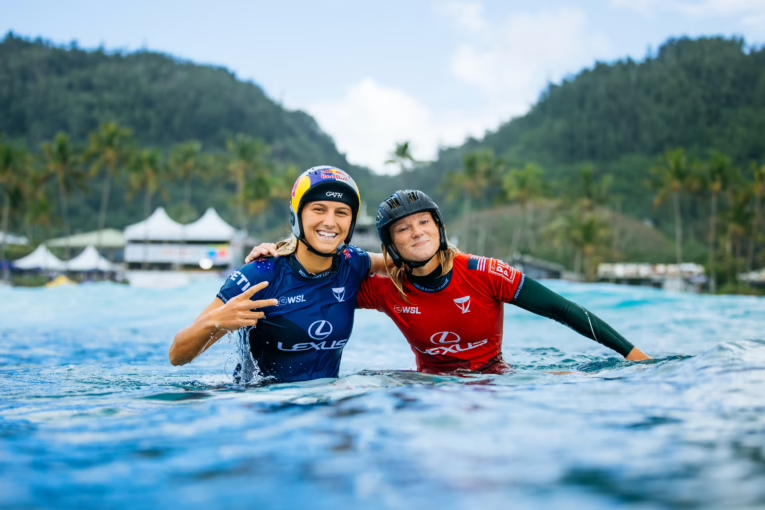Despite everything, in 2024 men still get the mine and women still get the shaft!
Six years ago today, the WSL announced that female athletes would receive the same prize money as men across all its events.
A landmark decision and a first among US-based sports leagues.
The equity-minded folks of the WSL followed that up in 2022 by fully aligning the stops on the Women’s Championship Tour with the Men’s, bringing the top surf ladies of the world back to hallowed and dangerous locations like Pipeline and Teahupo’o.
Gender equality locked and loaded.
Or is it?
Every surfer knows that the most valuable currency among surfers is not money, but waves. And if we look at equity in terms of quality waves, it paints a very different picture.
Sunset notwithstanding, the first half of this year was a shocker for waves on the Championship Tour. Surf fans endured the spectacle of pivotal heats going down in blown-out, marginally small or inconsistent conditions.
(As an aside, you can always tell a crap day of competitive surfing by how the highlights video is edited – unremarkable single manoeuvres intercut with lots of b-roll? Them some shitty waves…)
If you’ve clicked on the links above, you may have noticed a pattern: the ladies feature heavily.
The picture becomes even clearer if we look at the numbers.
Behold my pie charts, coded in Surfline-speak.
The men have actually done OK this year. They’ve only had to deal with six days (out of 32) held in “poor” or “poor to fair” waves.
Meanwhile, the long-suffering women of the CT have done nearly a third of their surfing (nine out of 28 days) in “poor” or “poor to fair” waves. For ladies who were unlucky enough to suffer the dreaded mid-season cut, over half of their run days were on the crappy end of things.
The tragedy of this is that when the girls have been sent out in epic conditions, we’ve seen some all-time performances: Molly Picklum charging a perfect Pipeline pit that would’ve got at least a 9 in a men’s heat, and then whacking a massive Sunset section that many male pros would dodge; Tatiana Weston-Webb earning a proper 10 in a throaty Teahupo’o pit; Erin Brooks threading caves and whacking sections with whiplike poise at Cloudbreak.
The consensus is clear among surf fans, male and female alike: the women’s competition has been more exciting than the men’s this year.
So why are we sending them (and not the men) out in blown-out side-shore slop in Portugal, tiny Pipeline and even smaller Margaret River?
Sure, we’ve come a long way since the bad old days when the women would be sent out once the tide or wind had gone real bad. But we’re still far from the promised land of equity and equality.
Jerusalem next year?
Meanwhile, there is another dimension by which the WSL is unequal.
At the start of each year, the Championship tour boasts a stable of 34 men and just 16 women. At the mid-year cut that’s whittled down to 22 men and 10 women. At no point does the number of women on tour reach even half the number of men.
(There’s another statistic for you).
It’s hard to argue that we need more than 16 women on tour at this point in women’s surfing. If you look down the competitive ranks, there’s just a of couple ladies who have never featured as full-time competitors on the Championship Tour and who look like they belong there. That’s Erin Brooks and Sierra Kerr. Erin’s well on her way to clinching her spot on the CT for 2025, and Sierra will follow soonish.
What’s easier to argue is that 34 men is far too many. There are some talents who would miss out on qualification if we dropped the number of surfers on tour. But it’s indisputable that the current men’s draw is bloated to the max in terms of scheduling. Before the cut, the first 16 men’s heats eliminates just four surfers. That’s over a full day of competition spent lightly rearranging the basement of the rankings. Sometimes, that first day of near-meaningless heats has wasted the very best conditions of the waiting period.
My favourite fix here is to rip the band-aid off and cut the men’s draw down to 23 surfers. This would not only move the number of surfers on tour to a more equitable split, but also make it easier to send the women out in waves that don’t suck.
What’s more, the wave quality for the men would improve too.
With less heats to run, it’s way easier for contest directors to be picky about the conditions. For evidence, just look at how much better the second half of the year has been compared to the first half.
Huey has been slightly kinder to the WSL in recent months, but the difference in the pie charts below is principally that events before the cut need around five full days to run, and after the cut only need three days.
Will the WSL do the right thing and move towards both gender equality and a better quality product?
Probably not this year, or the next.
But as the shift of Finals Day from Lower Trestles this year to Cloudbreak next year illustrates, if enough people start calling bullshit on their current modus operandi they’ll eventually bite.











